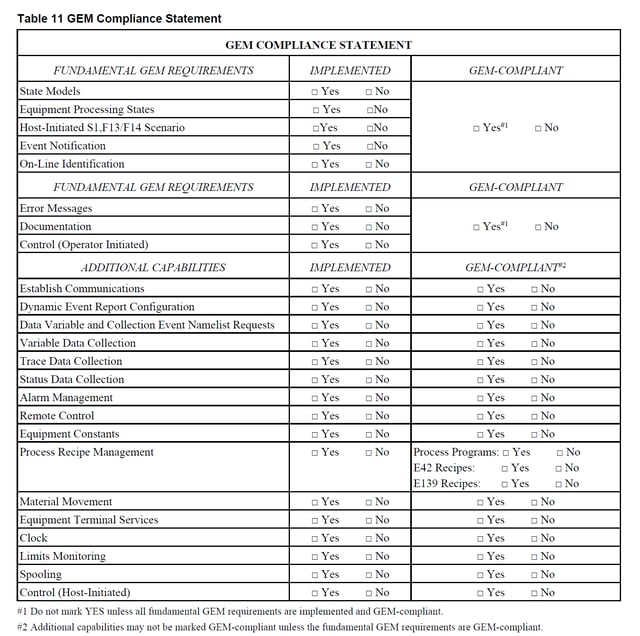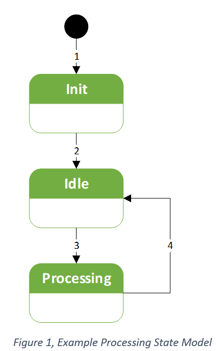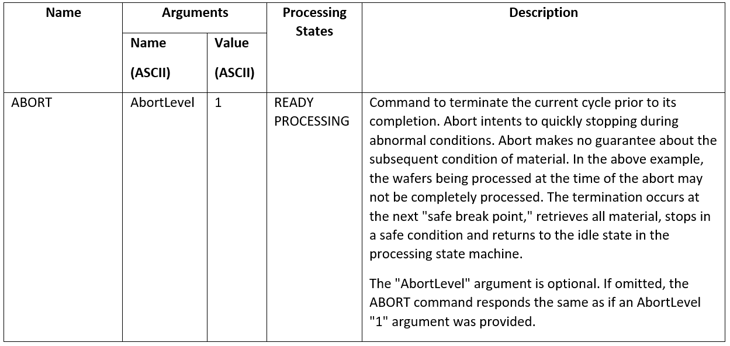 As the first article in this Features and Benefits of SECS/GEM series points out, the SECS/GEM standards define a standardized interface that may be used on any equipment. A GEM interface exposes an equipment's capabilities through status variables, data variables, collection events, alarms, data formats, error codes, SECS-II messages, and other optional GEM capabilities. The GEM standard requires each equipment to come with documentation; ensuring a factory has the information it needs to use an equipment’s GEM interface. This documentation is commonly referred to as the GEM manual.
As the first article in this Features and Benefits of SECS/GEM series points out, the SECS/GEM standards define a standardized interface that may be used on any equipment. A GEM interface exposes an equipment's capabilities through status variables, data variables, collection events, alarms, data formats, error codes, SECS-II messages, and other optional GEM capabilities. The GEM standard requires each equipment to come with documentation; ensuring a factory has the information it needs to use an equipment’s GEM interface. This documentation is commonly referred to as the GEM manual.
The GEM manual may be distributed in many ways. Currently, most GEM manuals are provided digitally in a Word, Excel, or PDF document. The vast amount of information in a GEM manual is used to make purchasing decisions, develop host software, and test equipment. For a full GEM interface, the GEM manual must include the following topics: State Models, Scenarios, Data Collection, Alarm management, Remote Control, Equipment Constants, Process Recipe Management, Material Movement, Terminal Services, Error Messages, Clock, Spooling, Control, Supported SECS-II messages, GEM Compliance statement, and Data Item Formats. To keep this post a reasonable length, we will only cover a few of the required topics.
GEM Compliance Statement
The compliance statement is one of the first topics to be reviewed. It is a quick and easy way to understand the features of an equipment’s interface. The manufacturer is required to mark which GEM capabilities are implemented on the equipment, and if they are implemented in a way that is compliant with the GEM standard.

State Models
State Models is a fundamental GEM capability, and is therefore implemented on every equipment. This capability defines the Communication, Control, and spooling behavior of the equipment. A processing state model must be provided. However, it is not possible to define a processing state machine that can be used on every equipment. The processing behaviors that should be the same for all equipment are specified by the standard. Each state model must be documented with a state model diagram, a transition table, and a text description of every state. The consistent and detailed information about each state model enables a factory to start writing a host application as soon as they have the GEM manual.

Alarms, Collection Events, Equipment Constants, Data Variables, and Status Variables
Alarms, Collection Events, and Variables are large components in gathering data from an equipment. It should not be a surprise that these are required to be in the GEM manual. Each alarm on the equipment should have its ID, name, description, and associated Set/Clear events in the GEM manual. The documentation for each collection event should include the ID, name, description, and a list of associated variables. The documentation for all variables will include an ID, name, description, and the data type. Information about a variables default value or value range should also be provided when appropriate. Although not required, it is common to display all this information in five tables that are easy to find. There would be a single table for each of the following: alarms, collection events, equipment constants, data variables, and status variables. See the examples below.
Alarms

Collection Events

Status Variables

Remote Control
Once a factory can gather data from an equipment they start looking at how to control the equipment. Remote Control is the GEM capability that allows a host application to request an equipment to perform an action. Each remote command should be in the manual with its name, description, and details about each command parameter that may be sent with the command. The details of a command parameter should include the name, the format, and a description. An example is shown below.

SMN and SEDD
GEM manuals rarely come in a format that is easy to parse in software. This often results in duplicating code and making small changes in order to communicate with other equipment. SEMI E172 SECS Equipment Data Dictionary (SEDD) and E173 SECS Message Notation (SMN) are two standards that can drastically increase the flexibility and reusability of a host application. SEDD is an xml file that is easily distributed and parsed in software. SEDD can be considered a modernized GEM manual because it contains much of the same information that is found in a GEM manual. For example, a SEDD file contains details about every variable, collection event, alarm, and supported SECS-II message. A SEDD file uses SMN to represent the data items, variables, and SECS-II messages. SMN is also XML and is the first standard to define a notation for representing data items and SECS-II messages. This means a single application can read a SEDD file, have a short configuration process, and then immediately start using the GEM interface of an equipment. These features allow a single application to be used with multiple equipment instead of creating slightly different variants for each equipment.
Wrap up
The GEM manual is a crucial piece of documentation that is required by the GEM standard to be provided with every equipment. The GEM Manual should be the first place to look for an answer when there is a question about an equipment’s GEM interface. SEMI continues to improve the content and flexibility of a GEM manual by updating existing standards and creating new standards.
Click here to read the other articles in our SECS/GEM Features and Benefits series.
To download a white paper on an introduction to SECS/GEM, Click below:





